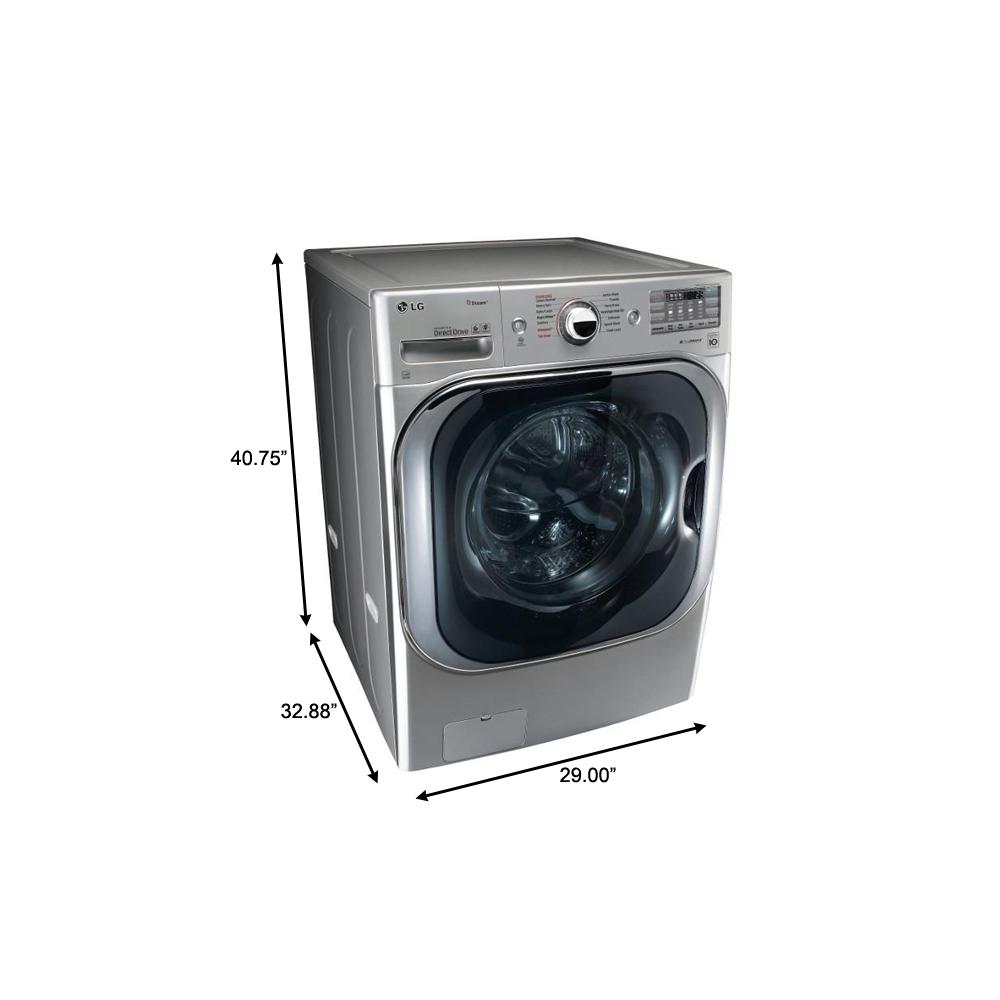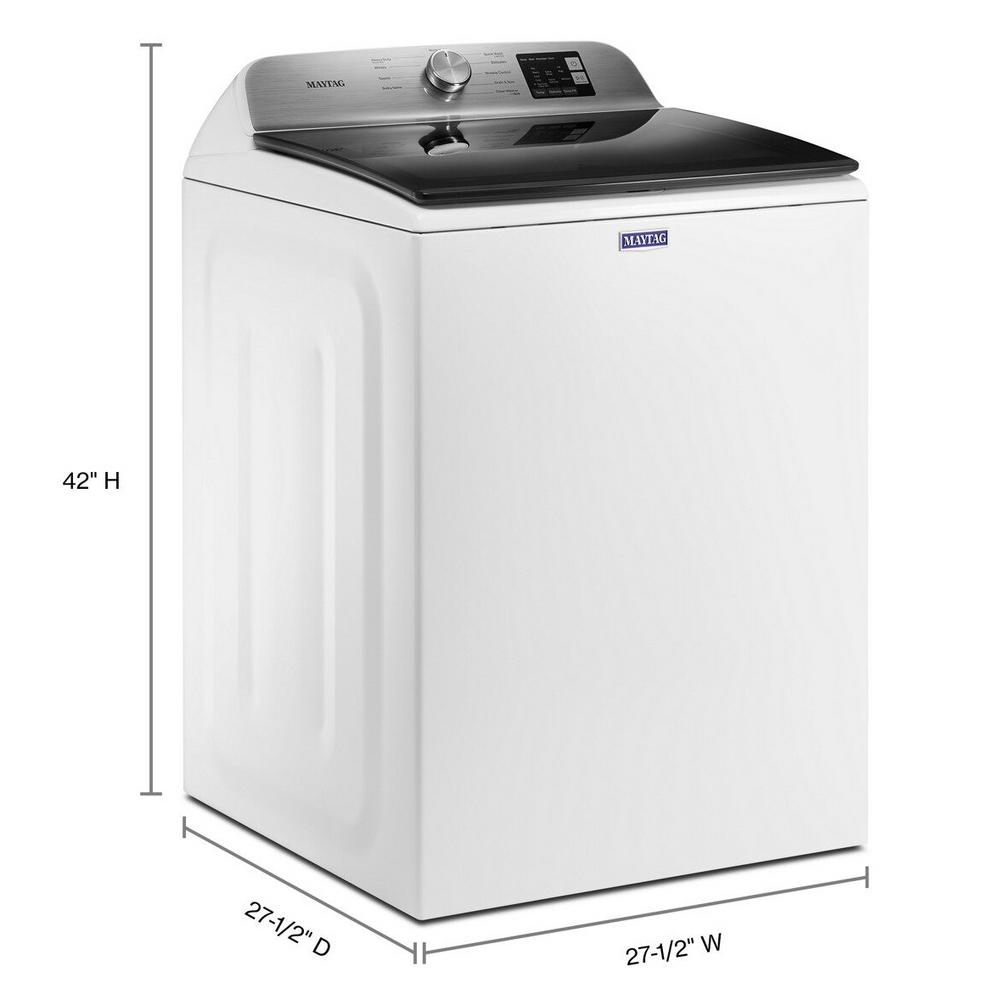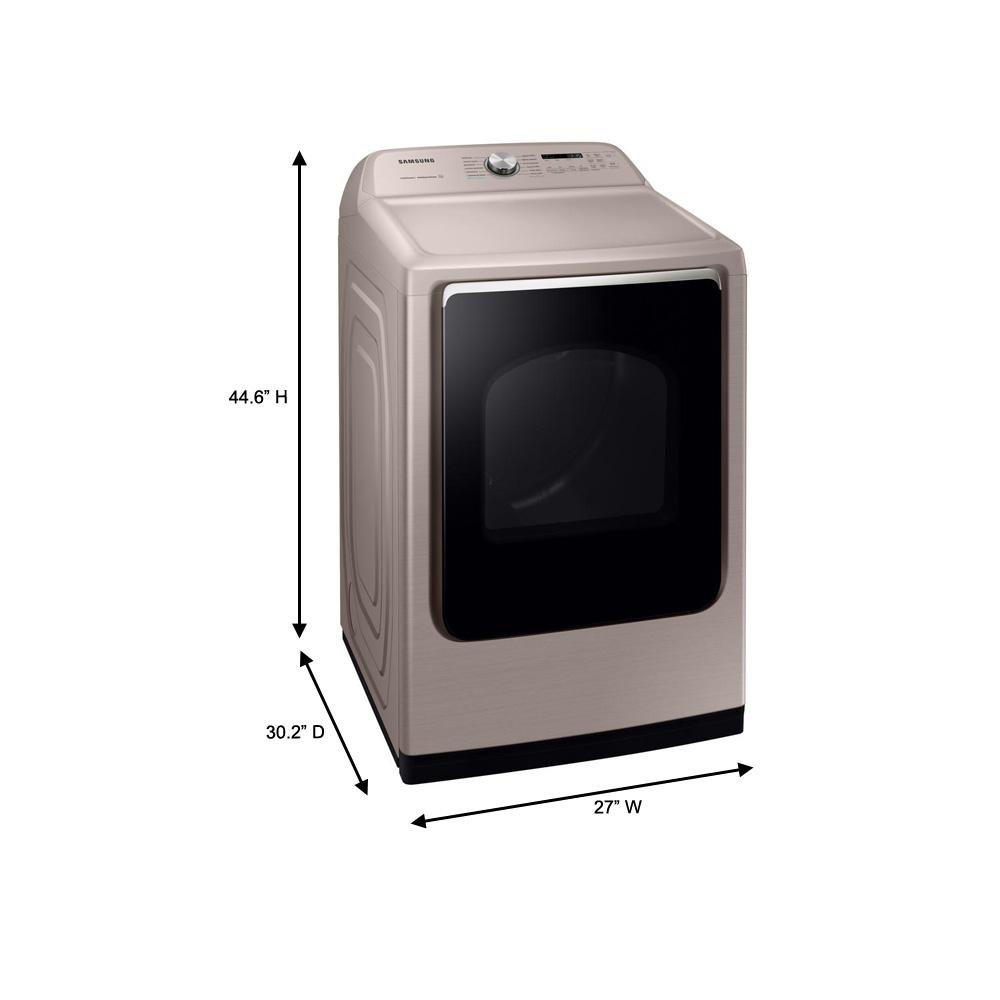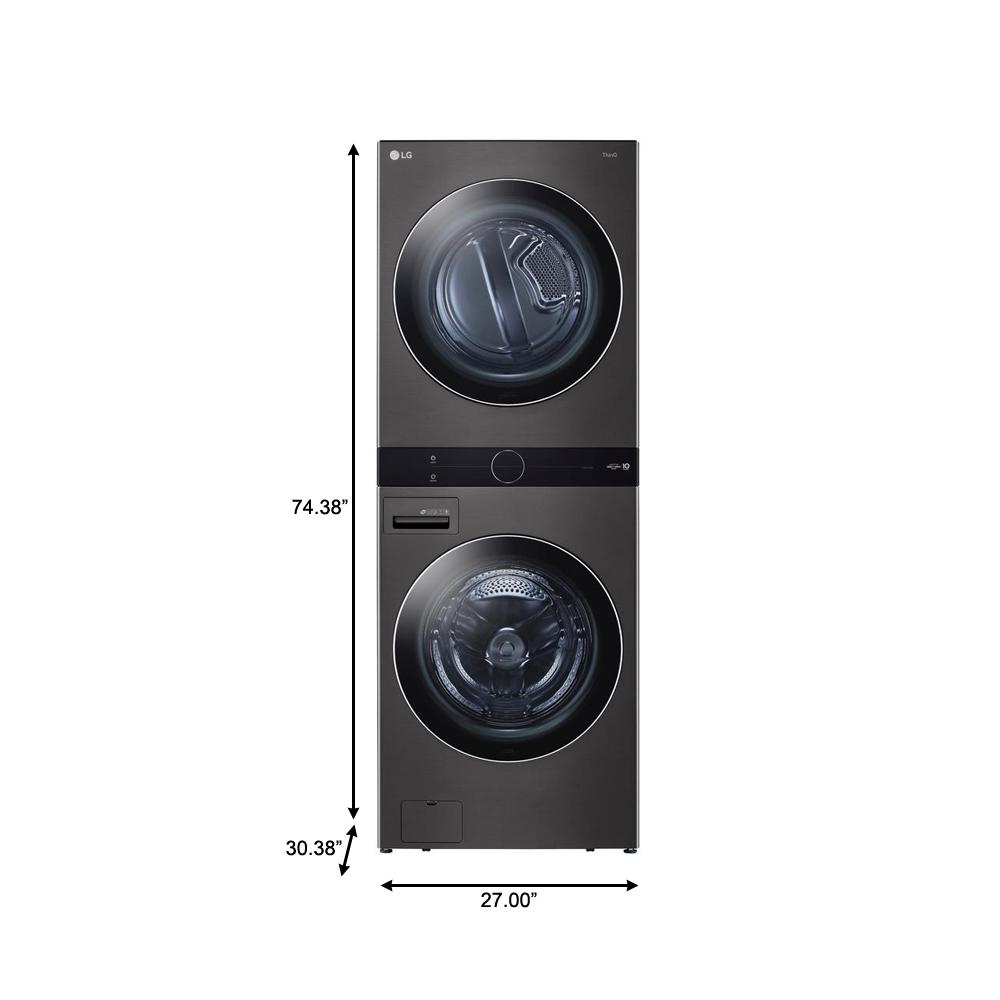LG Electronics 5.2 cu. ft. High Efficiency Mega Capacity Front Load Washer with Steam and TurboWash in Graphite Steel, ENERGY STAR
Save up to 30 minutes per load with new LG TurboWash Technology. Stackable w/ LG washer/dryer set & SideKick pedestal compatible. Steam washing machine eliminates dirt, odor, stains, and wrinkles.
Imagine being able to wash a king size comforter and a full set of bedding in a single load. And just think how much more amazing this would be if you could tackle a regular load of laundry 20 minutes faster. Stop imagining and go for it. LG takes the industry’s largest capacity washer and powers it to the max with time-saving TurboWash technology and a steam cleaning feature that virtually eliminates dirt, wrinkles and odors.
-
The largest capacity washer available at 5.2 cu. ft., you can fit a comforter and full set of king size bedding in a single load
- Electronic control panel with dual LED display and dial-a-cycle makes selecting the right easy
- LG’s revolutionary Turbowash technology allows you to wash larger loads 20 minutes faster, with outstanding cleaning performance
- Awarded the 2015 ENERGY STAR most efficient designation
- Each wash cycle combines up to 6 different wash motions to provide a revolutionary cleaning experience with 6Motion technology
- 14 wash cycles, including AAFA- Certified Allergiene, NSF-certified sanitary and hand wash/wool
- Cold wash technology uses cold water and enhanced washing motions to deliver cold-water saving with a warm-water performance
- Saving energy doesn’t have to mean compromising on cleaning with the ColdWash option; powered by the LG Direct Drive Motor and 6Motion technology, it’s ideal for cleaning all types of clothes – even those you normally wash in warm water; can be used with almost any wash cycle and virtually all fabric types
- Steam technology deeply penetrates fabrics to know out dirt and reduce wrinkles and odors while it also uses less water than traditional washers, so you won’t take a bath on your bills
- Allergiene cycle helps remove more than 95% of common household allergens, including dust mites and pet dander, helping to improve clothing hygiene
- Truebalance anti-vibration system is designed to minimize washer vibration for smooth, quiet performance in any room of the house – even on the 2nd floor
- The sense clean wash system sets the water and wash time automatically based on the weight and size of each load for optimal washing care
- Washer requires use of only high-efficiency detergent, typically two tablespoons per load
- The Home Depot will not hook up your washer with used fill hoses; new fill hoses will be offered during appliance checkout
- ENERGY STAR qualified to meet or exceed federal guidelines for energy efficiency for year-round energy and money savings
- Inverter DirectDrive Motor is backed by a 10-year limited warranty
- Capacity to wash as many items of clothing as the tub allows; as long as the lid shuts and locks, it will wash
- LG offers a lifetime warranty on the drum. All compatible LG washers, dryer, SideKick pedestal washers, and laundry pedestals sold separately
- Stackable design lets you stack the washer with matching dryer and optional stacking kit (not included) for a complete laundry set-up
Additional information
| Capacity - Washer (cu. ft.) | 5.2 |
|---|---|
| Depth With Door Open 90 Degrees (In) | 57.5 |
| Door Opening Height x Width (In.) | 16.93 x 16.93 |
| Product Depth x Height x Width (in.) | 32.88 x 40.75 x 29 |
| Certifications and Listings | UL Listed |
| Manufacturer Warranty | 1 Year Warranty: Parts and Labor, In-Home, 10 Years: Direct Drive Motor, Limited Lifetime: Stainless Steel Drum |
2 (two) is a number, numeral and digit. It is the natural number following 1 and preceding 3. It is the smallest and only even prime number. Because it forms the basis of a duality, it has religious and spiritual significance in many cultures.
5 (five) is a number, numeral and digit. It is the natural number, and cardinal number, following 4 and preceding 6, and is a prime number. It has garnered attention throughout history in part because distal extremities in humans typically contain five digits.
Five is the third-smallest prime number, and the second super-prime, since its prime index is prime. Notably, 5 is equal to the sum of the only consecutive primes 2 + 3 and it is the only number that is part of more than one pair of twin primes, (3, 5) and (5, 7), also making it the first balanced prime with equal-sized prime gaps above and below it (of 2). 5 is the first safe prime where for a prime is also prime (2), and the first good prime, since it is the first prime number whose square (25) is greater than the product of any two primes at the same number of positions before and after it in the sequence of primes (i.e., 3 × 7 = 21 and 11 × 2 = 22 are less than 25). 11, the fifth prime number, is the next good prime, that also forms the first pair of sexy primes with 5. More significantly, the fifth Heegner number that forms an imaginary quadratic field with unique factorization is also 11 (and the first repunit prime in decimal, a base in-which five is also the first non-trivial 1-automorphic number).
Five is also the second Fermat prime, and the third Mersenne prime exponent, as well as the fourth or fifth Fibonacci number. It is also an Eisenstein prime (like 11) with no imaginary part and real part of the form . It is the first congruent number, as well as the length of the hypotenuse of the smallest integer-sided right triangle, making part of the smallest Pythagorean triple (3, 4, 5). The regular five-sided pentagon is the first regular polygon that does not tile the plane with copies of itself, and it is the largest face that a regular three-dimensional regular Platonic solid can have, as represented in the regular dodecahedron. In general, a conic curve will requires five points in the same way that two points are needed to determine a line.
Efficiency is the often measurable ability to avoid making mistakes or wasting materials, energy, efforts, money, and time while performing a task. In a more general sense, it is the ability to do things well, successfully, and without waste.
In more mathematical or scientific terms, it signifies the level of performance that uses the least amount of inputs to achieve the highest amount of output. It often specifically comprises the capability of a specific application of effort to produce a specific outcome with a minimum amount or quantity of waste, expense, or unnecessary effort. Efficiency refers to very different inputs and outputs in different fields and industries. In 2019, the European Commission said: "Resource efficiency means using the Earth's limited resources in a sustainable manner while minimising impacts on the environment. It allows us to create more with less and to deliver greater value with less input."
Writer Deborah Stone notes that efficiency is "not a goal in itself. It is not something we want for its own sake, but rather because it helps us attain more of the things we value."
Electronics is a scientific and engineering discipline that studies and applies the principles of physics to design, create, and operate devices that manipulate electrons and other electrically charged particles. Electronics is a subfield of electrical engineering which uses active devices such as transistors, diodes, and integrated circuits to control and amplify the flow of electric current and to convert it from one form to another, such as from alternating current (AC) to direct current (DC) or from analog signals to digital signals.
Electronic devices have hugely influenced the development of many aspects of modern society, such as telecommunications, entertainment, education, health care, industry, and security. The main driving force behind the advancement of electronics is the semiconductor industry, which in response to global demand continually produces ever-more sophisticated electronic devices and circuits. The semiconductor industry is one of the largest and most profitable sectors in the global economy, with annual revenues exceeding $481 billion in 2018. The electronics industry also encompasses other sectors that rely on electronic devices and systems, such as e-commerce, which generated over $29 trillion in online sales in 2017.
Graphite () is a crystalline form of the element carbon. It consists of stacked layers of graphene. Graphite occurs naturally and is the most stable form of carbon under standard conditions. Synthetic and natural graphite are consumed on a large scale (1.3 million metric tons per year in 2022) for uses in pencils, lubricants, and electrodes. Under high pressures and temperatures it converts to diamond. It is a good (but not excellent) conductor of both heat and electricity.
LG Corporation (or LG Group), formerly known as Lucky-Goldstar, is a South Korean multinational conglomerate founded by Koo In-hwoi and managed by successive generations of his family. It is the fourth-largest chaebol (family-run conglomerate) in South Korea. Its headquarters are in the LG Twin Towers building in Yeouido-dong, Yeongdeungpo District, Seoul. LG makes electronics, chemicals, household appliances, and telecommunications products and operates subsidiaries such as LG Electronics, Zenith, LG Display, LG Uplus, LG Innotek, LG Chem, and LG Energy Solution in over 80 countries.
Steam is a substance containing water in the gas phase, often mixed with air and/or an aerosol of liquid water droplets. This may occur due to evaporation or due to boiling, where heat is applied until water reaches the enthalpy of vaporization. Steam that is saturated or superheated (water vapor) is invisible; however, wet steam, a visible mist or aerosol of water droplets, is often referred to as "steam".: 6
Water increases in volume by 1,700 times at standard temperature and pressure; this change in volume can be converted into mechanical work by steam engines such as reciprocating piston type engines and steam turbines, which are a sub-group of steam engines. Piston type steam engines played a central role in the Industrial Revolution and modern steam turbines are used to generate more than 80% of the world's electricity. If liquid water comes in contact with a very hot surface or depressurizes quickly below its vapor pressure, it can create a steam explosion.
Steel is an alloy of iron and carbon with improved strength and fracture resistance compared to other forms of iron. Because of its high tensile strength and low cost, steel is one of the most commonly manufactured materials in the world. Steel is used in buildings, as concrete reinforcing rods, in bridges, infrastructure, tools, ships, trains, cars, bicycles, machines, electrical appliances, furniture, and weapons.
Iron is always the main element in steel, but many other elements may be present or added. Stainless steels, which are resistant to corrosion and oxidation, typically need an additional 11% chromium.
Iron is the base metal of steel. Depending on the temperature, it can take two crystalline forms (allotropic forms): body-centred cubic and face-centred cubic. The interaction of the allotropes of iron with the alloying elements, primarily carbon, gives steel and cast iron their range of unique properties. In pure iron, the crystal structure has relatively little resistance to the iron atoms slipping past one another, and so pure iron is quite ductile, or soft and easily formed. In steel, small amounts of carbon, other elements, and inclusions within the iron act as hardening agents that prevent the movement of dislocations.
The carbon in typical steel alloys may contribute up to 2.14% of its weight. Varying the amount of carbon and many other alloying elements, as well as controlling their chemical and physical makeup in the final steel (either as solute elements, or as precipitated phases), impedes the movement of the dislocations that make pure iron ductile, and thus controls and enhances its qualities. These qualities include the hardness, quenching behaviour, need for annealing, tempering behaviour, yield strength, and tensile strength of the resulting steel. The increase in steel's strength compared to pure iron is possible only by reducing iron's ductility.
Steel was produced in bloomery furnaces for thousands of years, but its large-scale, industrial use began only after more efficient production methods were devised in the 17th century, with the introduction of the blast furnace and production of crucible steel. This was followed by the Bessemer process in England in the mid-19th century, and then by the open-hearth furnace. With the invention of the Bessemer process, a new era of mass-produced steel began. Mild steel replaced wrought iron. The German states were the major steel producers in Europe in the 19th century. American steel production was centered in Pittsburgh, Bethlehem, Pennsylvania, and Cleveland until the late 20th century.
Further refinements in the process, such as basic oxygen steelmaking (BOS), largely replaced earlier methods by further lowering the cost of production and increasing the quality of the final product. Today more than 1.6 billion tons of steel is produced annually. Modern steel is generally identified by various grades defined by assorted standards organizations. The modern steel industry is one of the largest manufacturing industries in the world, but also one of the most energy and greenhouse gas emission intense industries, contributing 8% of global emissions. However, steel is also very reusable: it is one of the world's most-recycled materials, with a recycling rate of over 60% globally.
Washer most commonly refers to:
- Washer (hardware), a thin usually disc-shaped plate with a hole in the middle typically used with a bolt or nut
- Washing machine, for cleaning clothes
Washer may also refer to:
- Dishwasher, a machine for cleaning dishware, cookware and cutlery
- Dishwasher (occupation), a person who cleans dishware, cookware and cutlery
- Washer, a person with obsessive-compulsive disorder who washes her/his hands compulsively
- Washer method, a mathematical formula for finding volume
- Washer pitching, an outdoor game involving tossing discs at a target
With or WITH may refer to:
- With, a preposition in English
- Carl Johannes With (1877–1923), Danish doctor and arachnologist
- With (character), a character in D. N. Angel
- With (novel), a novel by Donald Harrington
- With (album), a 2014 album by TVXQ
- With (EP), a 2021 EP by Nam Woo-hyun






by Mike
Happy wife happy life. She loves it. Extremely quiet compared to the last one
by Phil
Great washer. Cleans well. Controls Vibration well. Sound loudness is good and better than our previous LG washer. We like the happy tones it makes when the loads are done. Being able to put larger loads into the washer is great. We chose not to have a floor pedestal below to put cabinets above it. Only gave it a 4 out of 5 stars because the water in the door does not fully drain out so when you open the door it drips out a small amount of water every time after use. It does not leak while operating.
by Rob
Great washer beautiful to look at also.
by Chris
I am very happy with this dryer. I purchased it to pair the washing machine since these appliances are visible from my kitchen. Although, I have only had this for a few weeks, I’m very satisfied with my purchase thus far.
by Lisa
This dryer is awesome! Takes no time to dry and my clothes come out wrinkle free (even when it’s at max capacity!!!) So glad we chose this washer and dryer set!
by Lefers
Works great for me! So happy I got the 29″ LG WM8100HVA & DLEX8100V set. I got the WD200CV Sidekick & WDP5V pedestal drawer to match. I purchased this set to replace an old Kenmore top load set we purchased in 2002. What a huge difference! Wish I would’ve done it sooner… amazing at how much better this unit dries my clothes and larger items (like blankets and washable rugs)! Everything dries faster than it did in my old set and I usually set this unit on medium and that is more than enough heat to dry a large load is less than an hour (keep in mind the more heat, the more electric it will use so you’ll see it in your energy bill). Before I was having to run the old Kenmore dryer on high for 1-1/2 to 2 cycles of 70 min to get a larger load dry. This new unit has saved me so much time, and it’s definitely much easier on the clothes being on a slightly lower temp and being in there for less time. I’ve had the set for just over 6 months and no issues at all with dryer sheets sticking to the vent, or rust on the surface inside the unit. It really is a great dryer! Does really well on energy efficiency as well, hardly effects my usage at all which is awesome so it doesn’t make my electric bill go thru the roof. As for the steam function, I purchased this not realizing this wasn’t the same model I was expecting, and it wasn’t going to be plumbed in with the washer set. It’s a manual feature with a water tray drawer next to the control panel. It works fine really, but can be tedious if you have to add more water while using it. I did it with a couple non-washable rugs, and they came out beautifully refreshed so it functioned how it was meant to. I just had to add water a couple of times. Maybe cause it was the first time I added water to the machine? Either way for the minimal use of the steam feature, I’m OK with having to do that. All in all, it’s a solid unit and I would highly recommend it! If I had to buy again, I would choose this model in a heartbeat!